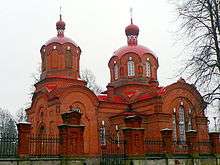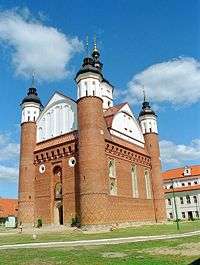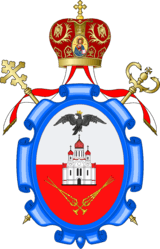Polish Orthodox Church
The Polish Autocephalous Orthodox Church (Polish: Polski Autokefaliczny Kościół Prawosławny), commonly known as the Polish Orthodox Church, or (Orthodox) Church of Poland is one of the autocephalous Eastern Orthodox Churches in full communion. The church was established in 1924, to accommodate Orthodox Christians of Polish descent in the eastern part of the country, when Poland regained its independence after the First World War.
In total, it has approximately 500,000 adherents (2016).[1] In the Polish census of 2011, 156,000 citizens declared themselves as members.[2]
History


The establishment of the church was undertaken after the Treaty of Riga left a large amount of territory previously under the control of the Russian Empire, as part of the Second Polish Republic. Eastern Orthodoxy was widespread in Western Belarus and the Ukrainian Volhynia. The loss of an ecclesiastical link, due to the persecution of the Russian Orthodox Church in the Soviet Union, left the regional clergy in a crisis , and in 1924, the Ecumenical Patriarchate took over establishing several autonomous churches on territories of the new states that were formerly wholly or partially part of the Russian Empire (Finland, the Baltic States, and Poland).[3] Earlier, in January 1922, the Polish government had issued an order recognizing the Orthodox church and placing it under the authority of the state. At that time a Ukrainian, Yurii Yaroshevsky, was appointed Metropolitan and exarch by the patriarch of Moscow. When Yaroshevsky began to reject the authority of Moscow Patriarchate, he was assassinated by a Russian monk.[4] Nonetheless, his successor, Dionizy Waledyński (Dionisii Valedinsky), continued to work for the autocephaly of the Polish Orthodox church, which was finally granted by the Ecumenical Patriarch of Constantinople in his Tomos of 13 November 1924.[5] Given that most of the parishioners were Ukrainians and Belarusians living in the Eastern areas of the newly independent Polish Second Republic, the Patriarch of Constantinople had a canonical basis to grant the Tomos to the Polish church as a successor of the Kyiv Metropolia, the former territory of Kyivan Rus' which Constantinople continued to see as its canonical territory (despite having agreed to allow Moscow to be its caretaker it in 1686).[6][7] The Russian Orthodox Church at the time did not recognise Constantinople's granting of Polish autocephaly.
During the interwar period, however, the Polish authorities imposed severe restrictions on the church and its clergy. In the most famous example, the Alexander Nevsky Cathedral in Warsaw was destroyed in the mid-1920s. In Volyhnia a total of 190 Eastern Orthodox churches were destroyed and a further 150 converted to Roman Catholicism.[8] Several court hearings against the Pochayiv Lavra also took place.[9]
After the Second World War most of the ethnically Ukrainian and Belarusian territories were annexed by the Soviet Union, holding up to 80% of the PAOC's parishes and congregation, which were united with the recently re-instated Moscow Patriarchate. The remaining parishes that were now on the territory of the Polish People's Republic were kept by the PAOC, including most of the mixed easternmost territories such as around Chełm and Białystok. In 1948, after the Soviet Union established political control over Poland, the Russian Orthodox Church recognised the autocephalous status of the Polish Orthodox Church.[4][10]
Although most of the congregation is historically centered in the Eastern borderland regions with considerable Belarusian and Ukrainian minorities, there are now many parishes across the country, as a result of Operation Vistula and other diaspora movements. There are also some adherents in Brazil, resulted from the 1989 canonical union between the hierarchy headed by Metropolitan Gabriel of Lisbon, formerly under the Church of the Genuine Orthodox Christians of Greece, and the Polish Orthodox Church.[11] The European bishops, however, have left the jurisdiction in 2000, which eventually resulted in senior Bishop Chrysostom being raised to archepiscopal dignity. There are now parishes in the states of Rio de Janeiro, Pernambuco and Paraíba, plus a monastery in João Pessoa.[11][12]
In 2003, following the decision of the Holy Sobor of Bishops of the Polish Autocephalous Orthodox Church, the New Martyrs of Chelm and Podlasie suffering persecution during the 1940s were canonized.[13]
Primates of the Church
The Polish Autocephalous Orthodox Church was established in 1924. Traditionally the primate of the church has the title Metropolitan of Warsaw and All Poland.
- Metropolitan Jerzy (Dionizy Waledyński) - Archbishop of Warsaw (1921-1923) (Predecessor for establishment of the structure of Polish Autocephalous Orthodox Church)
- Metropolitan Dionizy (Dionizy Waledyński) - Metropolitan of Warsaw and All Poland (1923-1948)
- Metropolitan Makary (Makary Oksijuk) - Metropolitan of Warsaw and All Poland (1951-1959)
- Metropolitan Tymoteusz (Tymoteusz Szretter) - Metropolitan of Warsaw and All Poland (1961-1962)
- Metropolitan Stefan (Stefan Rudyk) - Metropolitan of Warsaw and All Poland (1965-1969)
- Metropolitan Bazyli (Bazyli Doroszkiewicz) - Metropolitan of Warsaw and All Poland (1970-1998)
- Metropolitan Sawa (Sawa Hrycuniak) - Metropolitan of Warsaw and All Poland (1998–present)
Administration
The church is headed by the Archbishop of Warsaw and Metropolitan of All Poland: Sawa (Michał) Hrycuniak (1998–). It is divided into the following dioceses:[14]
Archdioceses and Archbishops
- Archdiocese of Warsaw and Bielsk : Sawa (Hrycuniak)
- Archdiocese of Białystok and Gdańsk : James (Kostiuczuk) (2008–)
- Archdiocese of Łódź and Poznań : Simon (Romańczuk) (1993–)
- Archdiocese of Wrocław and Szczecin : George (Pańkowski) (2017-)
- Archdiocese of Lublin and Chełm : Abel (Popławski) (2001–)
- Archdiocese of Przemyśl and Gorlice : Paisius (Martyniuk) (2016-)
- Archdiocese of Rio de Janeiro and Olinda-Recife : Chrysostom (Freire) (1992–)
- Diocese of Recife : Ambrose (Cubas) (1996–)
Titular Dioceses and Bishops
- Titular Diocese of Supraśl: Gregory (Charkiewicz) (2008–), Vicar Bishop for Białystok and Gdańsk[15]
- Titular Diocese of Siemiatycze: George (Mariusz) Pańkowski (2007–), Ordinary for the Polish Orthodox Military Ordinariate and Vicar Bishop for Warsaw and Bielsk
Other entities
- Polish Orthodox Military Ordinariate
See also
- Eastern Orthodox Communion
- Supraśl Lavra
- Union of Brest
- Warsaw Icon Museum
References
- Główny Urząd Statystyczny, Mały Rocznik Statystyczny Polski 2016, Warszawa 2017, tab. 18(80), s. 115.
- Paweł Ciecieląg, Andrzej Datko, Bożena Łazowska, Piotr Łysoń, Paweł Milcarek, Wojciech Sadłoń: 1050 lat chrześcijaństwa w Polsce. Warszawa: GUS, 2016, s. 73. ISBN 978-83-7027-606-5.
- M. Papierzyńska-Turek, Między tradycją a rzeczywistością. Państwo wobec prawosławia 1918–1939.
- Internet Encyclopedia of Ukraine, Polish Autocephalous Orthodox church, accessed 2 June 2020
- "Tomos". Orthodox Church of America - UAOC - Standing Episcopal Conference of Orthodox Bishops. Retrieved 2018-12-22.
- History of Christianity in Ukraine#Territories gained by Pereyaslav Rada
- "Ecumenical Patriarch Bartholomew: "As the Mother Church, it is reasonable to desire the restoration of unity for the divided ecclesiastical body in Ukraine" - News Releases - The Ecumenical Patriarchate". www.patriarchate.org. Retrieved 2018-10-28.
- Healy, R. and Dal Lago, E. The Shadow of Colonialism on Europe’s Modern Past.
- (in Ukrainian) ІСТОРИЧНА ВОЛИНЬ: Спроби ревіндикації луцького Свято-Троїцького собору
- "Statement of the Holy Synod of the Russian Orthodox Church concerning the uncanonical intervention of the Patriarchate of Constantinople in the canonical territory of the Russian Orthodox Church | The Russian Orthodox Church". mospat.ru. 14 September 2018. Retrieved 2018-10-20.
- (in Portuguese) Eparquia Ortodoxa do Brasil
- (in Portuguese) Mosteiro Ortodoxo da Dormição da Santa Mãe de Deus
- J. Charkiewicz, Męczennicy XX wieku. Martyrologia Prawosławia w Polsce w biografiach świętych.
- (in Polish) Polish Orthodox Church: Adminstracja
- (in Polish) Orthodox Diocese of Białystok and Gdańsk: Abp Jakub i Bp Grzegorz
External links
| Wikimedia Commons has media related to Orthodox churches in Poland. |
- Polish Orthodox Church, official site
- Polish Orthodox Church Unofficial Site (English)
- Polish Orthodox Diocese of Przemyśl-Nowy Sącz (Polish)
- Polish Orthodox Diocese of Lublin-Chełm (Polish)
- Polish Orthodox Diocese of Białystok-Gdańsk (English)
- Polish Orthodox Diocese of Wrocław-Szczecin (Polish)
- Polish Orthodox Military Ordinariat (Polish)
- Polish Orthodox Diocese of Brazil (Portuguese)
- Article by Ronald Roberson on the Polish Orthodox Church on CNEWA website
- orthodoxwiki:Church of Poland

